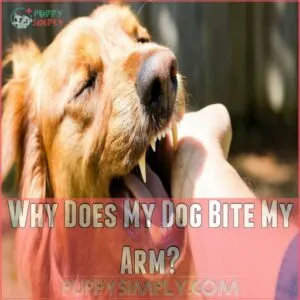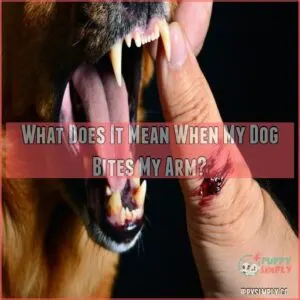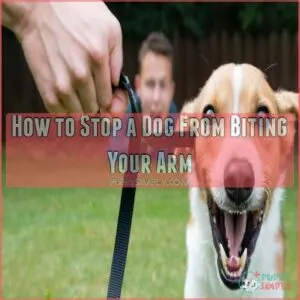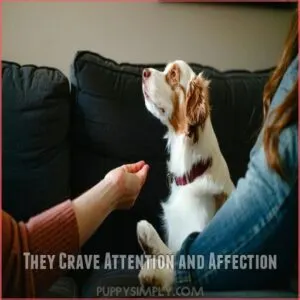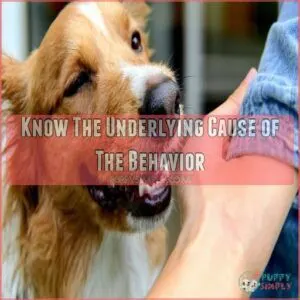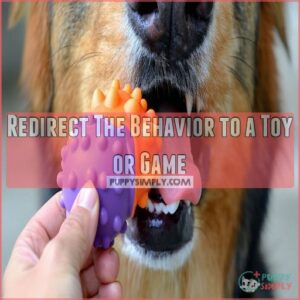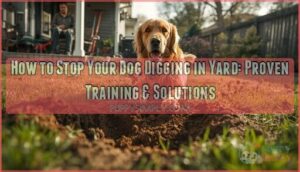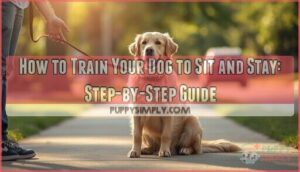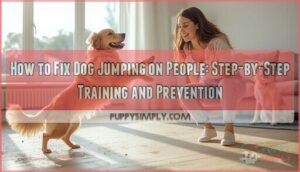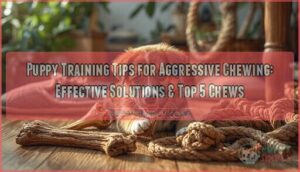This site is supported by our readers. We may earn a commission, at no cost to you, if you purchase through links.

Your pooch may be teething, playing, or seeking attention.
First, wash the wound with soap and water.
Then, redirect your dog’s mouthing to a chew toy.
Praise and reward them when they bite the toy instead of your arm.
With patience and consistent training, you can nip that habit in the bud.
But if the biting persists or seems aggressive, consult a vet.
They can check for any underlying medical issues and provide expert advice on curbing the behavior.
Don’t worry, there are plenty of ways to get Fido to stop chewing on you.
Table Of Contents
- Key Takeaways
- Why Does My Dog Bite My Arm?
- What Does It Mean When My Dog Bites My Arm?
- How to Stop a Dog From Biting Your Arm
- Reasons Dogs May Bite or Mouth Arms and Hands
- 5 Tips to Stop Your Dog From Grabbing Your Arm
- How to Determine if Your Dog is in Pain or Uncomfortable
- When to Seek Professional Help for Dog Biting and Mouthing
- Frequently Asked Questions (FAQs)
- Does a dog bite your arm?
- Can you get rabies from a dog if it nibbles you and there is a tiny cut?
- Why does my dog bite my arm?
- How do you stop a dog from biting your arm?
- Why does My Dog Bite my Hand?
- How do you train a puppy to bite your arm?
- How Do I Know if My Dog is Playing or Being Aggressive?
- How Do I Know When It’s Time to Seek Professional Help?
- What Age Should I Start Training My Dog to Prevent Biting?
- Is There Any Way to Prevent My Dog From Biting Altogether?
- How Do I Know if My Dog is in Pain or Uncomfortable When It Bites?
- What does it mean when your dog bites his arm?
- How do I get my dog to stop chewing on his arm?
- Why does my dog mouth my arm?
- How do you discipline a dog to stop biting?
- What behaviors indicate my dog may bite my arm?
- How can I desensitize my dog to not bite my arm?
- What are signs my dog is stressed or fearful of my arm?
- Should I let my dog chew on my arm during play?
- When does mouthing on my arm become a serious issue?
- Conclusion
Key Takeaways
- Identify the underlying reason for your dog’s arm biting, whether it’s teething, playful behavior, or attention-seeking, and address it accordingly.
- Redirect your dog’s mouthing urges to appropriate chew toys and interactive games, using positive reinforcement to encourage the right behaviors.
- Be patient and consistent in your training, celebrating small victories as your dog learns bite inhibition.
- Consult a professional dog trainer or behaviorist if the arm biting persists or becomes aggressive, as they can provide tailored solutions to address the issue.
Why Does My Dog Bite My Arm?
If your dog’s been biting your arm, don’t worry – it’s usually just normal puppy behavior.
Mouthing and nibbling is how dogs explore their world and communicate,
but you can stop it with a little patience and the right training.
Reasons for Dog Mouthing
Dogs mouth for various reasons.
Puppies often mouth due to teething, while adult dogs may mouth out of playfulness, excitement, or attention-seeking.
Identifying the underlying cause is key to addressing excessive mouthing.
For breeds like Dachshunds with a strong prey drive and hunting instincts, providing appropriate outlets, redirecting the behavior, and ensuring your dog’s needs are met can help curb this common canine behavior.
Teething and Mouthing
Teething is a common reason puppies under one year old may bite your arm.
As they lose their baby teeth, chewing helps relieve discomfort.
Provide plenty of safe teething toys to redirect this natural urge.
Be patient and consistent – with time and training, your pup will learn gentler ways to satisfy their need to chew.
Playful Mouthing and Socialization
Puppies often mouth and chew during playtime, a natural part of their socialization process.
This mouthing behavior helps them develop appropriate bite inhibition as they interact with littermates and learn to control the force of their jaws.
Look for playful body language like wagging tails, relaxed posture, and gentle nibbling – signs your pup is just having fun.
Attention-Seeking Mouthing
Your pup may be mouthing your arm to get your attention.
This attention-seeking behavior can become a habit if you accidentally reward it by giving them what they want – even by scolding or pushing them away.
Stay calm, ignore the mouthing, and redirect their energy to a toy or game.
Be consistent, and they’ll soon learn better ways to interact.
What Does It Mean When My Dog Bites My Arm?
Is your dog biting your arm?
Don’t worry, there’s usually a reason behind this behavior.
Understanding the difference between mouthing and biting can help you address the issue and keep your furry friend from hurting you, and knowing what foods can harm them, like those with poppy seeds causing toxicitypoppy seed toxicity, is just as crucial in maintaining a safe environment for your dog.
Mouthing Vs. Biting
Mouthing differs from biting – it’s less forceful and not intended to harm.
Mouthing is part of normal puppy behavior, while biting is used to warn or cause harm.
Some mouthing may be a form of dog love bites, which convey affection and connection.
The intensity and body language signal whether your dog is mouthing playfully or biting aggressively.
Understanding this distinction is key to addressing the behavior effectively.
Signs of Playful Mouthing
So, what’s playful mouthing all about?
Think of it like a dog’s version of a friendly chat.
Notice these signs:
- Body Language: Relaxed and tail wagging.
- Soft Mouth: Gentle nibbles without teeth marks.
- Vocalization: Playful barks or growls.
This is just your dog showcasing its playful energy and puppy teething instincts.
Signs of Aggressive Biting
Signs of aggressive biting include stiff body language, direct eye contact, growling, exposing teeth, and lip licking.
These indicate the dog feels threatened and may attack.
This is very different from the playful mouthing of a puppy.
Stay alert for these warning signs and address any aggression promptly with professional help.
How to Stop a Dog From Biting Your Arm
Stopping your dog from biting your arm can be a challenge, but with the right approach, you can curb this behavior.
Ignore mouthing, redirect your pup’s attention, and teach alternative, positive behaviors to keep those teeth off your skin.
Ignore Unwanted Behavior
When your dog starts mouthing your arm, the best approach is to ignore the behavior.
Avoid any eye contact or verbal acknowledgment, as this can inadvertently reinforce the mouthing.
Stay calm and consistent – your dog will quickly learn that mouthing gets them no attention.
This strategy, combined with positive reinforcement for good behavior, is key to curbing unwanted biting.
Redirect The Dog’s Attention
Imagine this: your dog is gnawing on your arm like it’s a chew toy.
Quick fix? Redirect that energy! Grab a favorite dog toy to keep them entertained.
Use distraction techniques like interactive games to shift their focus.
Positive reinforcement works wonders here; reward them when they choose a toy over your arm.
It’s all about redirecting behavior effectively.
Teach Alternative Behaviors
Redirecting your dog’s mouthing urges to more appropriate outlets is key.
Teach them to fetch a toy or "shake" as alternative behaviors.
Practicing simple commands like "leave it" can also help build impulse control.
With patience and consistency, you can replace biting habits with positive, rewarding interactions.
Provide Adequate Exercise and Stimulation
Preventing dog bites starts with addressing their underlying needs.
Make sure your pup gets plenty of daily exercise and mental stimulation.
A bored, pent-up dog is more likely to act out through mouthing or biting.
Provide puzzle toys, training sessions, and active playtime to keep their mind and body engaged.
Reasons Dogs May Bite or Mouth Arms and Hands
Your dog may bite or mouth your arms and hands for a few common reasons.
They may be seeking attention and affection or simply want to play and interact.
Understanding the underlying cause can help you address the behavior effectively.
They Crave Attention and Affection
Your dog may bite your arm when they crave your attention and affection.
These attention-seeking behaviors often involve mouthing, licking, or gentle biting.
You can also try redirecting their attention by providing them with a durable chew toy to satisfy their urge to mouth and chew.
Ignoring the unwanted behavior and providing positive reinforcement for calm interactions can help curb this habit.
With patient training, you can teach your dog alternative ways to get the attention they desire.
They Want to Play and Interact
If your pup is nipping or mouthing your arms, they’re likely just trying to play and interact. Puppies use their mouths to explore the world and bond with their pack – it’s a natural part of their development.
Provide plenty of appropriate play, like tug-of-war or fetch, and redirect mouthing to toys. This channels their energy into constructive play.
- Puppies mouth to play, bond, and explore
- Provide outlets like toys and games to redirect mouthing
- Avoid punishing playful nips – that can backfire
- Supervision and patience are key during this puppy phase
They Want to Stop Unwanted Actions
Dogs may mouth or bite your arm when they want to stop an unwanted action. For example, if you’re petting them and they’ve had enough, they may gently mouth your hand to communicate that. Redirect this behavior by teaching an alternative command like "shake" or "touch." Rewarding desired behaviors helps prevent biting.
| Reason for Mouthing | Solution |
|---|---|
| Stop Unwanted Touch | Teach "Shake" or "Touch" |
| Prevent Removal | Reward Calm Behavior |
| Gain Attention | Ignore Biting, Reward Calm |
| Alleviate Boredom | Increase Exercise/Enrichment |
| Medical Issue | Consult Veterinarian |
They Seek Food or Rewards
Have you noticed your dog nipping at your arm when you’re eating? It’s a common problem.
This behavior often stems from food motivation; your dog associates your arm with the possibility of tasty treats.
They may even be exhibiting signs of food aggression in dogs, such as growling or teeth baring.
They’re basically trying to "get their paws" on a snack.
Positive reinforcement, like using food rewards during training, can redirect this behavior.
Remember, treat training isn’t just about tricks; it’s about building a better bond and managing unwanted behaviors.
Consistent reward-driven behavior training is key.
5 Tips to Stop Your Dog From Grabbing Your Arm
If your dog can’t seem to stop grabbing your arm, we’ve got the tips you need to put an end to that pesky behavior for good.
From redirecting their attention to teaching new tricks, you’ll be on your way to a bite-free relationship in no time.
Know The Underlying Cause of The Behavior
Determining the underlying cause of your dog’s arm-biting behavior is key to finding an effective solution. Is your pup teething and needs more chew toys? Are they seeking attention or playtime? Understanding the root trigger will guide your training approach to curb this unwanted habit.
- Identify the specific trigger(s) causing the mouthing behavior.
- Consider whether the behavior stems from boredom, stress, or lack of exercise.
- Rule out any medical issues that could be causing discomfort or pain.
Prevent Unwanted Behavior and Mouthing
Fortunately, there are steps you can take to prevent unwanted mouthing and biting behaviors.
Start by redirecting your pup’s natural chewing instincts to appropriate toys and objects.
Consistently remove your arm when they mouth, and provide plenty of interactive play and exercise to curb excess energy.
| Action | Benefit |
|---|---|
| Redirect to Toys | Satisfies Chewing Needs |
| Avoid Rewarding Mouthing | Prevents Reinforcing Behavior |
| Make Sure They Get Enough Exercise | Reduces Boredom and Frustration |
| Use Positive Reinforcement | Encourages Desired Behaviors |
Redirect The Behavior to a Toy or Game
Redirect your dog’s mouthing urges by offering engaging toys and interactive games.
Fetch, tug-of-war, and sniff toys provide constructive outlets for their natural chewing and play instincts.
Quickly swap your arm with an approved chew object when they try to mouth you, praising and rewarding calm, toy-focused behavior.
Teach Your Dog to Shake Paws Instead
Teaching your dog to "shake" is a great alternative to mouthing and biting.
When they start going for your arm, quickly offer your hand and say "shake."
Reward with praise and treats when they comply.
This redirects their energy into a positive interaction, helping curb unwanted behaviors.
Be Patient and Consistent in Training
Consistent, patient training is key to stopping your dog from biting your arm.
Use positive reinforcement to build trust, and stick with it.
Your dog is learning, and with your guidance, they’ll soon have better bite inhibition.
Celebrate small victories, and don’t get discouraged by setbacks – progress takes time.
How to Determine if Your Dog is in Pain or Uncomfortable
If your dog is suddenly biting or mouthing your arm, it could be a sign they’re in pain or feeling uncomfortable.
Pay close attention to any changes in their behavior, like increased irritability or sensitivity.
Consult your veterinarian to address any underlying health issues, as pain or discomfort from health conditions can contribute to aggression, similar to factors influencing Shih Tzu aggression.
Signs of Pain or Discomfort in Dogs
Dogs can’t tell us when they’re in pain, but their body language often provides clues.
Look for limping, whining, lethargy, hiding, or changes in appetite – these may signal discomfort.
If your pup starts unexpectedly biting or mouthing your arm, it could indicate an underlying medical issue.
Pay close attention and consult your vet if you notice concerning behavioral changes.
Mouthing and Biting Due to Medical Issues
If your dog’s arm biting stems from an underlying medical issue, it’s important to get them checked out.
Pain, discomfort, or other health problems could be the root cause, and monitoring your dog for signs of discomfort and pain such as struggling to get up or growling is essential.
Address any underlying conditions first before attempting behavioral training.
A veterinary exam can uncover hidden issues and guide you toward the right solution.
Addressing Underlying Medical Conditions
When your furry friend starts unexpectedly chewing on your arm, it might be whispering, "Something’s not right!"
Medical causes like dental issues or arthritis can make your dog uneasy.
For instance, arthritis can be managed with supplements and dietary changes, such as incorporating arthritis dog treats.
Don’t brush it off—schedule a vet check to pinpoint dog health problems.
Prompt medical treatment can turn those nibbles back into happy tail wags.
It’s all about dog health!
When to Seek Professional Help for Dog Biting and Mouthing
If your dog’s biting or mouthing becomes frequent, aggressive, or unresponsive to your training efforts, it’s time to seek help from a professional dog trainer or behaviorist.
Professional dog trainers or behaviorists can identify the root cause and develop a customized plan to address your dog’s specific needs.
Signs of Aggressive Biting and Mouthing
Your dog’s mouthing may become more concerning if you notice signs of aggression, such as growling, lip curling, teeth baring, or a stiff, tense posture.
These behaviors indicate your pup is feeling threatened and may escalate to biting if not addressed properly.
Consult a professional dog trainer or behaviorist to develop a plan specific to your dog’s needs.
Addressing Persistent or Unwanted Behavior
Persistent dog biting behavior feels frustrating, but you’re not alone.
Address it by understanding triggers and using positive reinforcement.
Training techniques like consistent redirection help.
Dog Behavior Solutions. Understanding dog aggression is key to addressing unwanted behaviors like arm biting, which can be caused by fear-based aggression, resource guarding, or lack of socialization, and can be effectively managed with proper training techniques, such as positive reinforcement strategies
| Behavior | Trigger | Solution | Reinforcement |
|---|---|---|---|
| Mouthing | Stress | Relaxation | Praise |
| Biting | Excitement | Calm activities | Treats |
| Nipping | Play | Redirect | Toys |
| Chewing | Teething | Chew toys | Attention |
Consistency is key; seek professional help if needed.
Working With a Professional Dog Trainer
If your dog’s arm-biting behavior persists despite your best efforts, it’s wise to seek guidance from a qualified professional dog trainer.
They can assess the underlying causes, develop a customized training plan, and provide effective tools, such as those found in dog bite training products online (dog bite training aids).
They can offer:
- Proven techniques for addressing dog aggression issues, such as those caused by fear and resource guarding, can help modify your dog’s unwanted behaviors.
- Instruction to help you become an effective trainer.
- Ongoing support to help you make lasting positive changes.
Working with a certified expert can be the key to stopping your dog’s biting for good.
Frequently Asked Questions (FAQs)
Does a dog bite your arm?
Mouthing is a natural part of dog behavior, but bites can cause serious injury.
Stay alert, provide appropriate chew toys, and teach your dog gentle play.
With patience, you can curb excessive mouthing.
Can you get rabies from a dog if it nibbles you and there is a tiny cut?
You don’t need to worry about rabies if a dog just nibbles you and there’s a tiny cut.
But it’s still wise to clean the wound and watch for any signs of infection.
Why does my dog bite my arm?
Dogs may bite your arm for various reasons – teething, playfulness, excitement, or attention-seeking.
Avoid rewarding this behavior and teach alternative, positive ways for your dog to interact with you instead.
How do you stop a dog from biting your arm?
Suspense builds as your pup playfully nibbles.
Stay calm – mouthing’s normal, but redirecting to toys and rewarding gentle behavior will teach your furry friend bite inhibition.
With patience, you’ll curb those nips for good.
Why does My Dog Bite my Hand?
Puppies often mouth or chew on hands, arms, and clothing as a way to explore their world and relieve teething pain.
With proper training and patience, you can curb this natural behavior and teach your pup to play more gently.
How do you train a puppy to bite your arm?
I wouldn’t recommend training a puppy to bite your arm.
That could be dangerous and lead to long-term behavioral issues.
Instead, focus on positive reinforcement training to teach your puppy appropriate, non-harmful behaviors.
How Do I Know if My Dog is Playing or Being Aggressive?
You can tell if your dog is playing or being aggressive by watching their body language.
Playful dogs have a relaxed, wiggly posture, while aggressive dogs have stiff, direct movements.
Paying attention to your dog’s cues is key.
How Do I Know When It’s Time to Seek Professional Help?
When your dog’s mouthing escalates beyond playful nips, it’s time to bring in the professionals.
Consult a certified trainer to nip aggressive behavior in the bud and teach proper bite inhibition.
What Age Should I Start Training My Dog to Prevent Biting?
Start training your puppy the moment you bring them home.
Consistent, positive reinforcement from an early age helps prevent unwanted biting behaviors and promotes a well-adjusted, friendly dog.
Enlist professional help if mouthing persists past 6 months old.
Is There Any Way to Prevent My Dog From Biting Altogether?
Curb canine capers through thorough canine training, crafted with care and consistency. Consistent consequences, coupled with positive reinforcement, can quash biting altogether, ensuring your pup’s polite paws.
How Do I Know if My Dog is in Pain or Uncomfortable When It Bites?
If your dog bites out of pain or discomfort, you’ll likely notice signs like growling, lip-licking, or avoiding contact.
Address the underlying cause through veterinary care and gentle training to prevent future bites.
What does it mean when your dog bites his arm?
Like a rattlesnake’s rattle, your dog’s arm biting could signal discomfort or pain. Examine the area for injuries, then consult your vet to uncover the root cause and provide relief.
How do I get my dog to stop chewing on his arm?
To stop your dog from chewing their arm, try distracting them with treats or toys during the urge.
Provide plenty of exercise and chew-safe alternatives to redirect the behavior.
If the issue persists, consult your vet or a professional trainer.
Why does my dog mouth my arm?
Dachshunds, for instance, may exhibit this behavior due to their natural instinct to protect and defend, particularly around children if not properly socialized through positive reinforcement training methods. Dogs often mouth your arm out of natural puppy behavior, curiosity, or excitement.
It’s their way of exploring the world.
With patience and training, you can redirect this instinct to acceptable chew toys.
How do you discipline a dog to stop biting?
First, stay calm and avoid punishing the dog, which can make biting worse.
Instead, redirect your pup with positive reinforcement, like treats or praise, when they stop biting.
Provide chew toys to satisfy their natural urge to bite.
What behaviors indicate my dog may bite my arm?
If your dog’s hackles are raised, their gaze is fixed, and their body is stiff, those are red flags that a bite may be imminent.
Stay calm, avoid direct eye contact, and slowly back away to diffuse the situation.
How can I desensitize my dog to not bite my arm?
Desensitize your pup by gradually exposing them to your arm, rewarding calm behavior.
Start with simply placing the arm near, then slowly incorporate touch and handling over time.
Be patient – it takes time to build trust.
What are signs my dog is stressed or fearful of my arm?
Your dog may show stress or fear toward your arm by cowering, tucking the tail, avoiding eye contact, licking lips, yawning frequently, or showing whites of the eyes.
These subtle cues signal discomfort or fearfulness.
Should I let my dog chew on my arm during play?
Let’s steer clear of letting Fido chomp down on your arm, friend.
That can quickly lead to painful bites and instill bad habits.
Instead, provide appropriate chew toys to satisfy their urge and keep playtime safe for both of you.
When does mouthing on my arm become a serious issue?
Mouthing becomes a serious issue when it escalates into forceful biting that could potentially break skin or cause injury.
Redirect their energy to appropriate chew toys.
Pay close attention to your dog’s body language.
Conclusion
Ultimately, stopping your dog from biting your arm requires a combination of patience, consistency, and positive reinforcement.
By understanding the underlying causes and using effective training techniques, you can successfully curb this unwanted behavior and build a stronger bond with your furry companion.
Remember, a well-trained "dog biting arm" is a happy, healthy dog.
With the right approach, you can nip this habit in the bud and enjoy Fido’s affectionate companionship without fear of painful bites.

